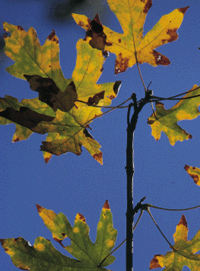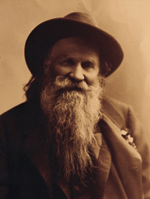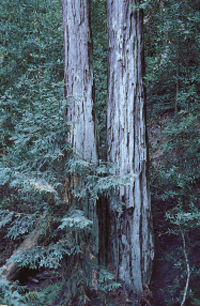Down in the depths of Palo Seco Canyon in Oakland’s Joaquin Miller Park, at the junction of Palo Seco Creek and Cinderella Creek, there is a delightful haven tucked away in the shadows beneath towering redwood trees.
You can find rest here in the quiet solitude and let the peace of the surroundings refresh your spirit. Once, a giant redwood stood at this junction; it was cut down in the great timber slaughter of the 1860s. Now a “fairy ring” of more recent generations has risen from the roots of the original and extends upward toward the sky. A few feet above the junction, Cinderella Creek trickles over the root dam of a resurrected redwood, and the musical water notes are haunting in their chattering flow. Some say there is a spiritual, or magical, quality at the junction, and if you gaze upward along the sheer straightness of the trunks, or let your eyes wander in the dark foliage of the bay trees clustered along the south canyon wall, you can almost imagine ghostly apparitions floating in the fragrant atmosphere.
Indeed, there is fuel for sensitive imaginations when you consider that Joaquin Miller’s funeral pyre is up at the top of the west ridge overlooking Palo Seco Canyon. Miller built the stone platform in 1906, intending to be cremated there Indian-style. However, when he died in 1913, city regulations prevented such an incendiary departure, so his soul had to be content with having his ashes scattered in the forest. In a sense, then, his particles are very much part of the park.
Joaquin Miller was born in Indiana in 1841, then traveled west to Oregon with his parents via covered wagon in 1846. He was a colorful character of the Gold Rush days around Mount Shasta, where he befriended the Modoc Indians and dreamed of becoming a writer. Before the 1880s, Miller worked as a rider for the Pony Express, a judge, a schoolteacher, and, above all, a poet. He lived in Europe for seven years, becoming something of a literary celebrity. He returned to the East Coast of the U.S. in 1881, continued writing, and built a log cabin in Washington D.C. adorned with animal skins and Indian artifacts. The cabin—and its occupant—became a major local attraction.
In 1885 Miller moved back to California to take a job as a writer for the monthly Golden Era. Looking for a refuge where he could concentrate on his writing—and offer inspiration to other artists—he took the $5,000 earned from the sale of his log cabin and bought 70 acres he called “The Hights” (sic) in the Oakland hills. From what we know of the ecology of the Oakland hills and can glean from early photographs, Miller’s property contained few trees at the time he acquired it. Being a man who was passionate in his love for trees (he established the first Arbor Day in California), Miller was quite eager to populate his new refuge with them. So he acquired some 75,000 Monterey pine and Monterey cypress saplings, as well as numerous non-native eucalyptus and olive trees, which he planted and nurtured with the aid of his ranch manager A. W. Darling, friends, and invited artists. While the Monterey pine is a native Californian, its normal habitat is in the coastal area around the Monterey peninsula. Miller chose the pine because of its ability to adapt to drier inland conditions.
- Joaquin Miller. Courtesy of the Oakland Public Library
In 1919, six years after Miller’s death, the City of Oakland had the foresight to purchase 68 acres of his estate, forming the nucleus of the 425-acre park that now bears the author’s name. The present park encompasses a variety of representative central coast range habitats, from hot open hillsides to cool redwood groves. It has become an invaluable asset for the adjoining city, a place where stressed urban dwellers can take refuge in the freshness of green open space, and find both insights into nature and opportunities for outdoor activity. Green corridors—like the Dimond Canyon passage that connects Joaquin Miller Park to the city below—offer additional urban lifelines of spiritual and physical renewal. It is not a pristine landscape, but rather a place where the hand of man and the embrace of nature exist in a dynamic equilibrium. A walk of discovery through several of the park’s habitats is a good introduction to both its natural features and its history of human impact.
A fine starting point for our walk is the Sequoia Arena parking lot off Skyline Road, where you can see a sample of Miller’s Monterey pine forest. Angle downhill left of the restrooms on to the Paul Covel Nature Trail (which coincides here with the Sequoia Bayview Trail) and go through a section of this open pine forest. These old Monterey pines have reached—and surpassed—their 80-year life span, and many have fallen to the ground and begun to decay. The aging tall-trunked pines are almost leafless below their uppermost branches. This allows light to filter through easily, creating excellent growing conditions for a variety of coast range shrub plants, including huckleberry, hazelnut, and cream bush. As these trees disintegrate, they provide a rich habitat for new pine sprouts, as well as for insects and other wildlife. You might see towhees, sparrows, scrub jays, wrentits, Cooper’s hawks, lizards, gopher snakes—and perhaps even a gray fox or a bobcat—all taking advantage of this altered, but healthy, habitat.
Many species of mushrooms grow in the pine duff after rains in the fall, including the highly-prized Italian mushroom, Boletus edulis, and the deadly, drab death cap, Amanita phalloides. Many, like the red russulas, Russula rosacea, grow in a mycorrhizal partnership with the pine roots. This is a relationship where the fungi mycelium covers the pine rootlets in a mutually beneficial exchange of nutrients. The rootlets provide the fungus with moisture and organic compounds, while the fungus aids the roots in the absorption of vital minerals.

- Big leaf maple leaves. Photo by Rex Burress.
Over the years, as Miller’s saplings developed into a mature pine forest, the park created a system of trails that brought increasing human use. This access has led to an exchange of lifeforms from other continents that has further altered the environment. At present, up to 50 percent of trailside plants in some parts of the park are of foreign origin: mustard, fennel, poison hemlock, scarlet pimpernel, various annual grasses, chickweed, three kinds of broom, and milk thistle are examples of the plant invasion. Some of the foreign species become an interesting addition to the wild plant matrix; others, like star thistle and French broom, crowd out the natives and disrupt the wild community.
The next segment of the walk, the Chaparral Trail, features healthy stands of native chaparral flora—including chamise, toyon, scrub oak, and coyote brush—living side by side with some of the introduced plants. There are also several healthy blue elderberry shrubs; by October, most of their small, clustered, bluish-gray berries will have been eaten by the birds. There is not much autumnal color change in this evergreen mosaic, although the toyon produces bright red berries in November.
One reason the shrub community appears so lush and healthy in this sector is that fire has not ravaged the hillside for many years. Although controlled fire burns are utilized on other public lands to reduce the fuel load, such measures are not an option in this canyon, with hundreds of homes just over the ridge.
The Chaparral Trail heads downhill to the Sunset Trail, which follows the creek along a lush riparian zone. This creekside habitat is the haunt of salamanders, banana slugs, and birds that live in the shadows, such as owls and the sensitive hermit thrush. Here, handsome big-leaf maple glows yellow in the autumn and yerba buena spreads its herbal aroma. Watch for healthy stands of bracken fern and for nine-bark shrubs that grow along the trail as you approach The Meadow picnic area. Bracken is a summer fern that grows well on hotter slopes than most other ferns will tolerate. It has large branching leaves which become yellowish in the fall. The young unfurled fiddleheads which appear in springtime can be eaten cooked or raw. Nine-bark has a currant-like leaf, textured and roughly serrated at the edge, and has round, creamy blossoms in spring. The pliable reddish stems were utilized by the native Ohlone as basket material.
Follow the Sunset Trail south to the Fern Ravine Trail, which will take you back uphill through a small sampling of a coastal redwood forest. These relatively young trees remind us of the drastic change that occurred in the Oakland hills landscape in the 1860s, when a magnificent grove of redwoods was completely devastated. Giant Sequoia sempervirens up to 32 feet in diameter grew in a two- by five-mile strip of especially fertile damp soil; they were visible enough for sailing ships to use as navigational landmarks as they entered the Bay at the Golden Gate. Smaller groves radiated down the canyons and into what is now Redwood Regional Park. Within ten years, those giants were completely gone, felled to fuel the construction boom in the new cities below. Secondary growth has reforested the park, and it is now considered the largest urban redwood forest in the world, but all the mighty behemoths are gone. Sword fern, huckleberry, and redwood sorrel have survived, however, and you can visit the site of several old stumps on Big Trees Trail; a plaque clearly indicates the ring of roots where one of those giants grew.
What would Joaquin Miller think if he could return today and see the aging and the transition of the forest he planted, the introduced flora, and the system of trails attracting a medley of users in a park that bears his name? I think he would be pleased to know that his former home is considered Oakland’s “jewel” of the hills, much as Lake Merritt is the city’s downtown “jewel,” and that the two parks are among Oakland’s finest assets.
Getting There:
By bus: AC Transit bus #53 runs from Fruitvale BART to the Chabot Science Center, across from the Sequoia Arena trailhead. Call (510) 871-1717 for a current schedule.
By auto: Exit Highway 13 at Joaquin Miller Road, and drive southeast (uphill) to Skyline Boulevard. Turn left on to Skyline and continue about two miles to the Sequoia Arena entrance on the left (just before Chabot Science Center on the right). Trail maps are available at the park visitor center, on Sanborn Drive off Joaquin Miller.
On the Other Hand…
In his article on “The Changing Nature of Joaquin Miller Park” author Rex Burress wrote that the fiddle-heads of young bracken ferns are edible “either cooked or raw.” However, before you head out to pick ferns for your soup pot, you might want to heed the information brought to our attention by one very informed reader.
In January 1990, the state Office of Environmental Health Hazard Assessment added bracken fern to its list of known carcinogens. This list was developed and made available to the public as a consequence of Proposition 65, The Safe Drinking Water and Toxic Enforcement Act of 1986, which requires the governor to publish a list of known carcinogens (www.oehha.ca.gov).
In addition, the website of the World Health Organization’s International Agency for Research in Cancer (IARC) states that “bracken fern was tested for carcinogenicity by oral administration to mice, rats, guinea pigs, and toads. In all species except cows, bracken fern induced malignant or benign and malignant intestinal tumors” (www.iarc.fr).
This news may come as a bit of a shock to those who look forward to the spring fiddlehead season as a time to brighten up soups, salads, and stir fries. Through the 1980s, many naturalists regarded the young fronds of bracken fern as an edible delicacy. And indeed, the fiddlehead of the ostrich fern is safe to eat (though it does not grow wild in California).
Don’t let this cautionary note squelch your natural urge to sample the “fruits of the wild.” It is still a good way to interact with, and get to know, the natural environment around us. But exercise care and be well-informed when harvesting things to eat from nature. Be sure to check out both the toxicity of the poten-tial food and the health of its local population; after all, you wouldn’t want to contribute to the eradication of yet another native species from the Bay Area environment. There are many plants and fungi out there that are edible, safe, and abundant; please just take care.
Molly Steinberg

.jpg)





